Police, Protesters Clash as Flights Out of Hong Kong Are Canceled
For the second day in a row, demonstrators take over airport terminals to protest what many see as an erosion of freedoms promised in 1997.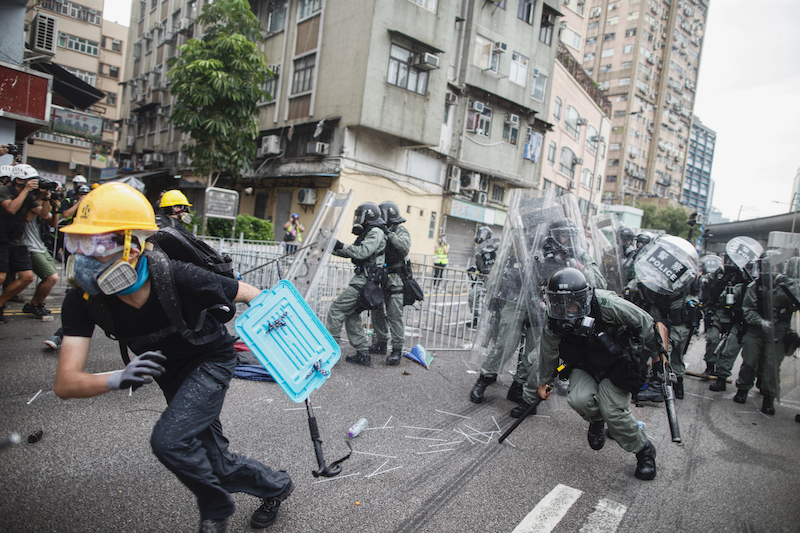 A protester flees from baton-wielding police officers in Hong Kong in July. (Eric Tsang / HK01 via AP)
A protester flees from baton-wielding police officers in Hong Kong in July. (Eric Tsang / HK01 via AP)
HONG KONG—Riot police clashed briefly with pro-democracy protesters at Hong Kong’s airport Tuesday night in a chaotic end to a second day of demonstrations that caused mass cancellations and disruptions at the Chinese city’s busy transport hub.
Calm eventually returned, with most of the protesters leaving the airport hours after officers armed with pepper spray and swinging batons tried to enter the terminal, fighting with demonstrators who barricaded entrances with luggage carts. Protesters said they planned to return to the airport early Wednesday.
The burst of violence also included protesters beating at least two men they suspected of being undercover agents and came the same day Hong Kong’s pro-Beijing leader warned that the demonstrators had pushed events onto a “path of no return,” highlighting the hardening positions on both sides.
Police took away several people they caught outside the arrival hall and eventually retreated.
Police said they were trying to help ambulance officers reach an injured man whom protesters had cornered and detained for about two hours on suspicion of being an undercover agent from mainland China. Rescuers eventually succeeded in getting him to an ambulance, local broadcaster RTHK reported.
Protesters then detained and beat a second man whom they also suspected of being an undercover agent.
After a brief period when planes were able to take off and land early in the day, authorities were forced to cancel the remaining flights. The airport authority suspended check-in services for departing flights as of 4:30 p.m., with departing flights that had completed the process able to continue to operate.
The airport’s website showed at least 120 cancellations and it advised people not to come to the airport, one of the world’s busiest.
More than 200 flights were canceled Monday and passengers were forced to stay in the city while airlines tried to find other ways to get them to their destinations.
The airport disruptions escalated a summer of demonstrations aimed at what many Hong Kong residents see as an increasing erosion of the freedoms they were promised in 1997 when Communist Party-ruled mainland China took over what had been a British colony.
The protests have built on an opposition movement that shut down much of the city for seven weeks in 2014 before it eventually fizzled and its leaders were jailed on public disturbance charges.
The central government in Beijing has ominously characterized the current protest movement as something approaching “terrorism” that poses an “existential threat” to citizens.
While Beijing tends to define terrorism broadly, extending it especially to nonviolent movements opposing government policies in minority regions such as Tibet and Xinjiang, its use of the term in relation to Hong Kong raised the prospect of greater violence and the possible suspension of legal rights for those detained.
Hong Kong leader Carrie Lam said the instability, chaos and violence have placed the city on a “path of no return.”
The black-clad demonstrators have shown no sign of letting up on their campaign to force Lam’s administration to respond to their demands, including that she step down and scrap proposed legislation under which some suspects could be sent to mainland China, where critics say they could face torture and unfair or politically charged trials.
Lam has rejected calls for dialogue, part of what analysts say is a strategy to wear down the opposition movement through police action while prompting demonstrators to take more violent and extreme actions that will turn the public against them. At the airport, protesters discussed among themselves whether they should simply block all access to the facility.
Meanwhile, paramilitary police were assembling across the border in the city of Shenzhen for exercises that some saw as a threat to increase force against the mostly young protesters who have turned out by the thousands in the past 10 weeks.
President Donald Trump tweeted that U.S. intelligence believes that the Chinese government is moving troops to its border with Hong Kong. He also tweeted that “Everyone should be calm and safe!” He provided no additional details.
While China has yet to threaten using the army — as it did against pro-democracy protesters in Beijing in 1989 — the Shenzhen exercises were a sign of its ability to crush the demonstrations, even at the cost to Hong Kong’s reputation as a safe haven for business and international exchange. Images on the internet showed armored personnel carriers belonging to the People’s Armed Police driving in a convoy Monday toward the site of the exercises.
The People’s Liberation Army has a garrison in Hong Kong, which recently released a video showing its units combating actors dressed as protesters. Hong Kong police also put on a display of water cannons.
Police have arrested more than 700 protesters since June and say they have infiltrated the movement, leading to concerns that officers were inciting violence. Scores of protesters and police have been hurt, including a woman reported to have had an eye ruptured by a beanbag round fired by police during clashes Sunday.
Police said they are investigating the incident, which protesters have taken up as a rallying cry. Some in the airport occupation wore gauze bandages dyed with artificial blood over one eye.
The U.N.’s top human rights official condemned violence around the protests and urged both sides to settle their dispute through “open and inclusive dialogue.”
Rupert Colville, spokesman for U.N. High Commissioner for Human Rights Michelle Bachelet, said her office had reviewed evidence that police are using “less-lethal weapons in ways that are prohibited by international norms and standards.” That includes firing tear gas canisters into crowded, enclosed areas and directly at individuals, “creating a considerable risk of death or serious injury,” Colville said in a statement.
In a sign of rising tensions, protesters in the evening detained two men they claimed were undercover police from mainland China. They tied his wrists with plastic strips and poured water over his head. Airport security guards did not appear to be able to stop the crowd.
Sally Tong, an 18-year-old protester, said they needed to hold him as evidence that mainland Chinese authorities are in Hong Kong to monitor the demonstrations. Tong said the man was dressed in black and wore a mask to look like one of them.
“We want to keep him here and investigate,” Tong said. Protesters said the man dropped his wallet when he was running away from them, and they found ID cards from mainland China and also found his name on a list of police officers online.
Protesters also bound the hands of the second man they captured. They grew enraged when they emptied out his belongings and found a blue T-shirt that has been worn by pro-Beijing supporters, which they said was evidence he was a spy.
Protesters said they detained him because he wore a press vest and claimed to be a reporter. They used a nearby U.S. flag to beat the man, who was on the floor in a fetal position, while journalists and pro-democracy lawmaker Kwok Ka-ki, who is a doctor, tried to stop them. The chaotic situation eventually ended when protesters allowed ambulance workers to take the man away on a stretcher.
The Associated Press could not independently verify their identities.
After two months, the protests have become increasingly divisive and prompted clashes across the city.
Demonstrators have recently focused on demanding an independent inquiry into what they call police abuse of power and negligence. That followed reports and video of violent arrests and injuries sustained by protesters.
Some protesters have thrown objects and police, and officials say several officers have suffered injuries.
Lam said dialogue would only begin when the violence ended. She reiterated her support for police and said they have had to make quick decisions under difficult circumstances, using “the lowest level of force.”
“After the violence has been stopped, and the chaotic situation that we are seeing could subside,” Lam said. “I as the chief executive will be responsible to rebuild Hong Kong’s economy … to help Hong Kong to move on.”
She did not elaborate on what conciliatory steps her government will take.
The early protests were in neighborhoods near government offices. However, the airport protest has had a direct impact on business travel and tourism. Analysts said it could make foreign investors think twice about Hong Kong, which has long prided itself as being Asia’s leading business city with convenient regional air links.
“I don’t think I will ever fly to Hong Kong again,” said Kerry Dickinson of South Africa.
The protesters held signs in Chinese and English to appeal to travelers from mainland China and elsewhere. “Democracy is a good thing,” said one sign in simplified Chinese characters.
Adding to the protesters’ anger, Hong Kong’s Cathay Pacific Airways told employees the carrier has a “zero tolerance” for them joining “illegal protests” and warned they could be fired.
___
Associated Press photographer Vincent Thian in Hong Kong, and writers Kelvin Chan and Sylvia Hui in London contributed.
Your support is crucial…With an uncertain future and a new administration casting doubt on press freedoms, the danger is clear: The truth is at risk.
Now is the time to give. Your tax-deductible support allows us to dig deeper, delivering fearless investigative reporting and analysis that exposes what’s really happening — without compromise.
Stand with our courageous journalists. Donate today to protect a free press, uphold democracy and unearth untold stories.
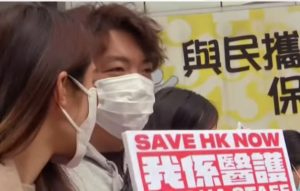

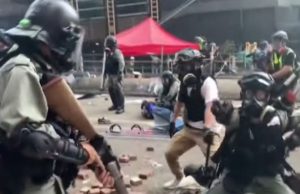
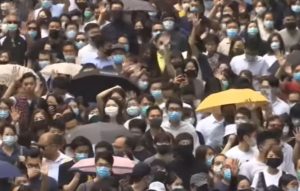
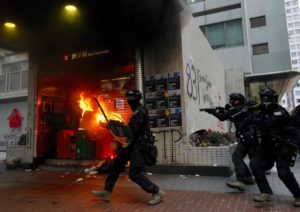
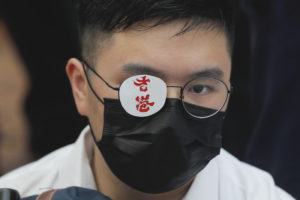
You need to be a supporter to comment.
There are currently no responses to this article.
Be the first to respond.